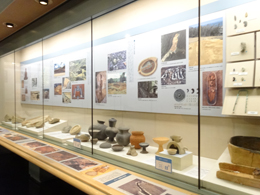Permanent Exhibition
Permanent Exhibition "History and Culture of Otsu"
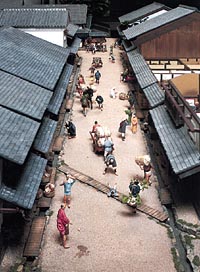
Both a rich historical and cultural legacy have been forged because of Otsu’s blessed nature?Lake Biwa and forested mountains. Since people f irst settled in Otsu, over 8,000 years ago during the Jomon Period, to today, the land has become a common setting in the course of history, and a constant focus of attention. This can be attributed to the fact that Otsu has long served as a center for transportation, tying the Kansai region together. Also, because Otsu stretches from north to south, early people came to develop their own unique histories and cultures. Through permanent exhibits, including “themed exhibits” that focus on a particular area of Otsu and “chronology exhibits” that introduce symbolic events of particular time periods, Otsu’s gradual development over time is made tangible.
floor
1F

themed exhibits
A.Katata and Hira Sanroku Villages
B.Mt. Hiei and its Base
C.Otsu Hyakucho
D.The Eight Views of Omi
E.The 60,000 Koku Fief of Zeze
F.Mini Special Exhibition
2F

themed exhibits
chronology exhibits
1.Primeval/Ancient Times
2.Middle Ages
3.Early Modern Ages
4.The Modern Era
themed exhibit
A. Katata and Hira Sanroku Villages
Based in Lake Biwa’s many bays, the water transportation and f ishing industries of Katata Village f lourished at the end of the Muromachi Period. A model of the village reconstructs how the village would have appeared during this time. This exhibit also introduces the history of the Hira Sanroku Villages, which were able to thrive due to Mt. Hira and Lake Biwa.
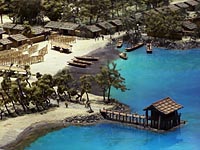
B. Mt. Hiei and its Base
This exhibit introduces the history of Sakamoto and Sakamoto Castle, which originally stood as towns built around Enryaku-ji and Hiyoshi-sha. A model displays the layout of Sakamoto as it would have appeared during the latter half of the Edo Period.
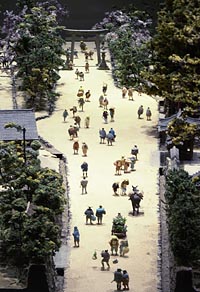
C. Otsu Hyakucho
This exhibit introduces the history of Otsucho, an area of Otsu that served as a port town and a center for water transportation, along with being a waypoint on the Tokaido road. A model recreates how the center of the waypoint and the town of Fudanotsuji would have appeared during the latter half of the Edo Period. Also, an area has been set up to display souvenirs long beloved by travelers: Otsu-e, abacuses, and Ikegawa sewing needles.
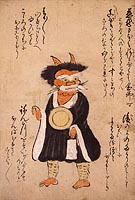
D. The Eight Views of Omi
A representative landmark of Omi’s lake country: The Eight Views of Omi. This locale’s beautiful nature is immortalized in many paintings and crafted artwork from the Edo Period. At this corner, archetypal ukiyo-e paintings by Utagawa Hiroshige are on display.
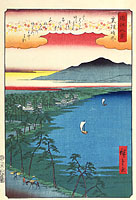
E. The 60,000 Koku Fief of Zeze
This exhibit introduces the history of the 60,000 koku (a unit of measure pertaining to volumes of rice; approximately 10.8 million liters) f ief of Zeze, which was ruled by the Hondashi Clan. This f ief included Zeze, the town surrounding the castle, and various other villages. A model displays how these areas would have appeared during the latter half of the Edo Period, and illustrations in the exhibit depict daily life within the domain. There is also an area dedicated to the master haiku poet, Matsuo Basho, who loved the scenery of Omi.
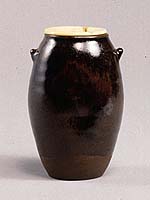
F. Oumi_Otsunomiya
This exhibit introduces the history of Oumi_Otsunomiya, which is rife with ancient ruins, through archaeological artifacts and illusions. A replication model of Otsu Palace based on the latest research is also on display.
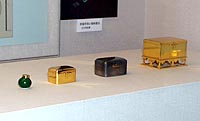
1〜5. Chronology Exhibit
This exhibit presents the history and culture of Otsu from primeval/ancient times to the modern day, and introduces events from each era through documents, photographs, and illustrations. On top of introducing various historical events, this exhibit also focuses in on some def ining matters from each time period. From primeval/ancient times, the exhibit contains a mound of shells from Ishiyama and shibi, or decorative roof tiles, (an irreplaceable cultural treasure) found at an archaeological site at Yama no Kami, dating back to the Jomon Period. From the middle ages, the exhibit displays information on the Kannon Pilgrimage, dating back to the Muromachi Period. From the early modern ages, information on the Siege of Otsu Castle and the Battle of Sekigahara, along with what Otsu was like during the upheaval of the Tokugawa shogunate, is on display. Finally, from the modern era, information on steam boats, the railway system, the Otsu Incident, and more is on display.

